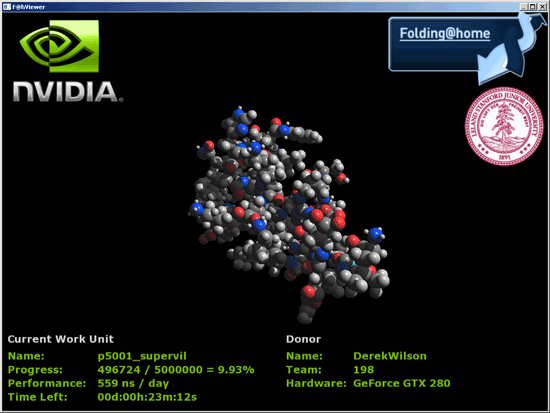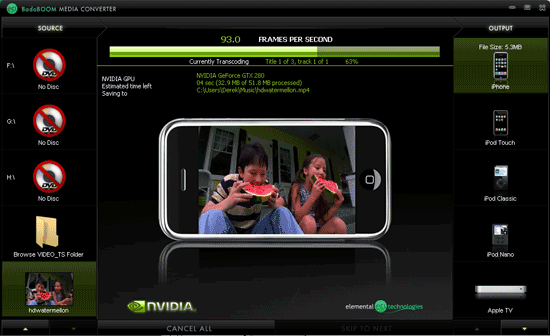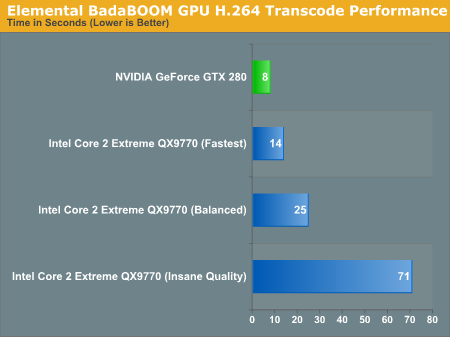NVIDIA's 1.4 Billion Transistor GPU: GT200 Arrives as the GeForce GTX 280 & 260
by Anand Lal Shimpi & Derek Wilson on June 16, 2008 9:00 AM EST- Posted in
- GPUs
Folding@home Now on NVIDIA
Folding@home, for those who don't know, is a distributed computing app designed to help researchers better understand the process of protien folding. Knowing more about how protiens assemble themselves can help us better understand many diseases such as alzheimers, but protien folding is very complex and takes a long time to simulate. the problem is made much easier by breaking it up into smaller parts and allowing many people to work on the problem.
Most of this work has been done on the CPU, but PS3 and AMD R5xx GPUs have been able to fold for a while now. Recently support for AMD's R6xx lineup was added as well. NVIDIA GPUs haven't been enabled to run folding@home until now (or very soon anyway). Stanford has finally implemented a version of folding@home with CUDA support that will allow all G80 and higher hardware to run the client.

We've had the chance for the past couple days to play around with a pre-beta version of the folding client, and running folding on NVIDIA hardwarwe is definitly very fast. Work units and protiens are different on CPUs and GPUs because the hardware is suited to different tasks, but to give some perspective a quadcore CPU could simulate tens of nanoseconds of a protien fold, while GPUs can simulate hundreds.
While we don't have the ability to bring you any useful comparative benchmarks right now, Stanford is working on implemeting some standard test cases that can be run on different hardware. This will help us actually compare the performance of different hardware in a meaningful way. Right now giving you numbers to compare CPUs, PS3s, AMD and NVIDIA GPUs would be like directly comparing framerates from different games on different hardware as if they were related.
What we will say is that NVIDIA predicts that the GTX 280 will be capable of simulating something between 5 and 6 hundred nanoseconds of folding per day while CPUs are going to be two orders of magnitude slower. They also show the GTX 280 handily ahead of any current AMD solutions by high margins, but until we can test it ourselves we really don't want to put a finer point on it.
In our tests, we've actually seen the GT200 folding client perform at between 600 and 850ns per day (using the timestamps in the log file to determine performance), so we are quite impressed. Work units complete about every 20 to 25 minutes depending on the protien and whether or not the viewer is running (which does have a significant impact since the calculations and the display are both running on the GPU).
Hardware H.264 Encoding
For years now both ATI and NVIDIA have been boasting about how much better their GPUs were for video encoding than Intel's CPUs. They promised multi-fold speedups in performance but never delivered, so we've been stuck encoding and transcoding videos on CPUs.
With the GT200, NVIDIA has taken one step closer to actually delivering on these promises. We got a copy of a severely limited beta of Elemental Technologies' BadaBOOM Media Converter:

The media converter currently only works on the GeForce GTX 280 and GTX 260, but when it ships there will be support for G80/G92 based GPUs as well. The arguably more frustrating issue with it today is its lack of support for CPU-based encoding, so we can't actually make an apples-to-apples comparison to CPUs or other GPUs. The demo will also only encode up to 2 minutes of video.
With that out of the way however, BadaBOOM will perform H.264 encoding on your GPU. There is still a significant amount of work being done on the CPU during the encode, our Core 2 Extreme QX9770 was at 20 - 30% CPU utilization during the entire encode process, but it's better than the 50 - 100% it would normally be at if we were encoding on the CPU alone.
Then there's the speedup. We can't perform a true apples-to-apples comparison since we can't use BadaBOOM's H.264 encoder on anything else, but compared to using the open source x264 encoder the performance speedup is pretty good. We used AutoMKV and played with its presets to vary quality:

In the worst case scenario, the GTX 280 is around 40% faster than encoding on Intel's fastest CPU alone. In the best case scenario however, the GTX 280 can complete the encoding task in 1/10th the time.
We're not sure where a true apples-to-apples comparison would end up, but somewhere between those two extremes is probably a good guesstimate. Hopefully we'll see more examples of GPU based video encoder applications in the future as there seems to be a lot of potential here. Given how long it takes to encode a Blu-ray movie, we needn't even explain why it's necessary.










108 Comments
View All Comments
elchanan - Monday, June 30, 2008 - link
VERY eye-opening discussion on TMT. Thank you for it.I've been trying to understand how GPUs can be competitive for scientific applications which require lots of inter-process communication, and "local" memory, and this appears to be an elegant solution for both.
I can identify the weak points of it being hard to program for, as well as requiring many parallel threads to make it practical.
But are there other weak points?
Is there some memory-usage profile, or inter-process data bandwidth, where the trick doesn't work?
Perhaps some other algorithm characteristic which GPUs can't address well?
Think - Friday, June 20, 2008 - link
This card is a junk bond when taking into consideration cost/perfomance/power consumption.Reminds me of a 1976 Cadillac with a 7.7litre v8 with only 210 horsepower/3600 rpm.
It's a PIG.
Margalus - Tuesday, June 24, 2008 - link
this shows how many people don't run a dual monitor setup. I would snatch up one of these 260/280's over the gx2's anyday, gladly!!The performance may not be quite as good as an sli setup, but it will be much better than a single card which is what a lot of us are stuck with since you CANNOT run a dual monitor setup with sli!!!!!!!!!!!!!!!!!!!!!!!!!!!!!!!!!!!!!!!!!!!!!!!!!!!!!!!!
iamgud - Wednesday, June 18, 2008 - link
"I can has vertex data"LOL
These look fine, but need to be moved to 55nm. By the time I save up for one they will .
calyth - Tuesday, June 17, 2008 - link
Well what the heck are they doing with 1.4B transistors, which is becoming the largest die that TMSC has been producing so far?The larger the core, the more likely that an blemish would take out the core. As far as I know, didn't Phenom (4 cores on die) suffered low-yield problems?
gochichi - Tuesday, June 17, 2008 - link
You know, when you consider the price and you look at the benchmarks, you start looking for features and NVIDIA just doesn't have the features going on at all.COD4 -- Ran perfect at 1920x1200 with last gen stuff (the HD3870 and 8800GT(S))so now the benchmarks have to be for outrageous resolutions that a handful of monitors can handle (and those customers already bought SLI or XFIRE, or GTX2 etc.)
Crysis is a pig of a game, but it's not that great (it is a good technical preview though, I admit), and I don't think even these new cards really satisfy this system hog... so maybe this is a win, but I doubt too many people care... if you had an 8800GT or whatever, you're already played this game "well enough" on medium settings and are plenty tired of it. Though we'll surely fire it up in the future once our video cards "happen to be able to run it on high" very few people are going to go out of their way $500+ for this silly title.
In any case, then you look at ATI, and they have the HDMI audio, the DX 10.1 support and all they have to do at this point is A) Get a good price out the door, B) Make a good profit (make them cheap, which these NVIDIA are expensive to make, no doubt) and C) handily beat the 8800GTS and many of us are going to be sold.
These cards are what I would call a next gen preview. Some overheated prototypes of things to come. I doubt AMD will be as fast, and in fact I hope they aren't just as long as they keep the power consumption in check, the price, and the value (HDMI, DX10.1, etc).
Today's release reminded me that NVIDIA is the underdog, they are the company that released the FX series (desperate technology, like these are). ATI has been around well before 3DFX made 3d-accelerators. They were down for a bit, and we all said it was over for ATI but this desperate release from NVIDIA makes me think that ATI is going to be quite tought to beat.
Brazofuerte - Tuesday, June 17, 2008 - link
Can I go somewhere to find the exact settings used for these benchmarks? I appreciate the tech side of the write up but when it comes to determining whether I want one of these for my gaming machine (I ordered mine at midnight), I find HardOCP's numbers much more useful.woofermazing - Tuesday, June 17, 2008 - link
AMD/ATI isn't going to abandon the high end like your article implies. Their plan is to make a really good mid range chip, and ductape to cores together ala the X2's. Nvidia goes from the high-end down, ATI from the mid-end up. From the look of it, ATI might have the right idea, atleast this time around. I seriously doubt we'll see a two core version of this monster anytime soon.DerekWilson - Tuesday, June 17, 2008 - link
they are abandoning the high end single GPU ...we did state that they are planning on competing in the high end space with multiGPU cards, but that there are drawbacks to that.
we'll certainly have another article coming out sometime soon that looks a little more closely at AMD's strategy.
KeypoX - Tuesday, June 17, 2008 - link
i dont like it, not impressed either :(. Hopefully my 8800gt last for a while, far past this crap atleast